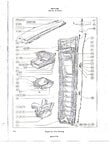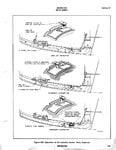So we basically have Spitfire MK Vs with 3 different armament setups, A number of different engines even if most of them were operated at the same performance levels if allowed to use the same boost. and we can throw in two different wing tips (but only on later Vbs and Vcs, late 1942?)
The P-40E has no change in armament, two possible engines (pre and post Dec 1941) and possible different max boost allowances based on engine (date of manufacture).This last is conjecture on my part, in any case the P-40K took over from the P-40E on the production lines in May of 1942.
The P-40E (Kittyhawk 1A) was basically a slightly modified P-40D (Kittyhawk I), of which 600 made, which was basically only in use by the British who got about 560 of them between April and September of 1941. The US got about 40 and deverted maybe of those 20 to Canada. They were in action with the DAF in Egypt by January 1942. The P-40D represetned the big change from the P-40B and C by shortening the nose and putting the big guns in the wing. The early P-40Ds had two guns in each wing, but probably most of them had the traditional three guns in each wing like the P-40E. They were plumbed for an external fuel tank or a bomb on the centerline.
There were 2500 P-40E / Kittyhawk IA built, with most of them (about 1,500) again going to the British, a few hundred were sent to Java and the Philippines shortly before being destroyed largely on the ground by the IJA and IJN, as well as about 300 which arrived too late so were diverted into the hands of the Australians* (but some of those sank in their crates inside transport ships on the way). A (to me) unknown number were sent to New Zealand, but probably no more than 100, and another 300 or so to the 23rd FG (former AVG) in China. The British also sent probably a couple of hundred to the Russians though some of those only after they had been used (and a little worn out) in the Middle East. They originally had the same engine (V-1710-39) as the P-40D but some were actually re-engined in the field or at maintenance depots with the V-1710-73, though that may have only been done in Australia / New Guinea. Later run P-40E had two wing hard points and the centerline external fuel tank /r bomb hard point. They were able to carry up to three 250 lb bombs or more rarely, two 500 lb bombs for short hops. About halfway through the production run they changed the method of ammunition storage which reduced stoppages during high G maneuvers.
The last variant in this closely related sub group is arguably the P-40K / Kittyhawk III - About 1,300 were made. 600 were sent to China (most ending up with the 23 FG but some also with CATF). 192 were sent to England with most of those ending up in the Middle East. 42 were sent to Australia, 22 to New Zealand and 25 were given or sold to Brazil, with most of the remaining 400 or so going to various units in the Pacific, and a few dozen being used briefly by the 57th FG in the MTO. At least 110 were sent to Russia from the US, possibly the British sent some of theirs as well. The K had a different ("rotary valve") cooling system and was given first a fin, then a lengthened tail (by 20") to improve stability. They had some kind of improved exhaust stacks. They used a different version of the M2 browning and like the late run E model had a different method of ammunition storage which reduced stoppages during high G maneuvers. They could routinely carry three 500 lb bombs and on occasion carried two 1,000 lb bombs for short missions.
My conjecture comes from Allison changing the crankshaft in the Allison engines in Dec of 1941. The new crankshaft was stronger and much more fatigue resistant. This is what allowed the engines in the P-40Ks to be rated at 1325hp for take-off. I believe that many late build P-40Es may have had these crankshafts.
I don't doubt that the older engines (all -39 engines) could be run at the high boost settings, the question might be for how long or how many times?
Official US approval for WEP settings was around 3/4 of a year after the change in the crankshafts?
Apparently in Australia they fitted several P-40E with V-1710-73
Allison also sent replacement engines which were probably midway in performance / toughness between -39 and -73. As you know there were at least two different modifications made to the crank shaft and they also made a change to the crank case and some other parts.
The official approval for the change in boost was lagging behind field conditions, but those were by British / Commonwealth units anyway for the most part over whom USAAF policies didn't matter so much. No US units flew P-40D or E in the Med. The need for overboosting wasn't as urgent in the Pacific though they did it there too of course (as noted in the infamous Allison memo).
* the Australians promptly lost about half of these during training accidents and in landing accidents while ferrying them in several flights from Southern Australia to the Darwin area and then Port Morseby.
Last edited:




